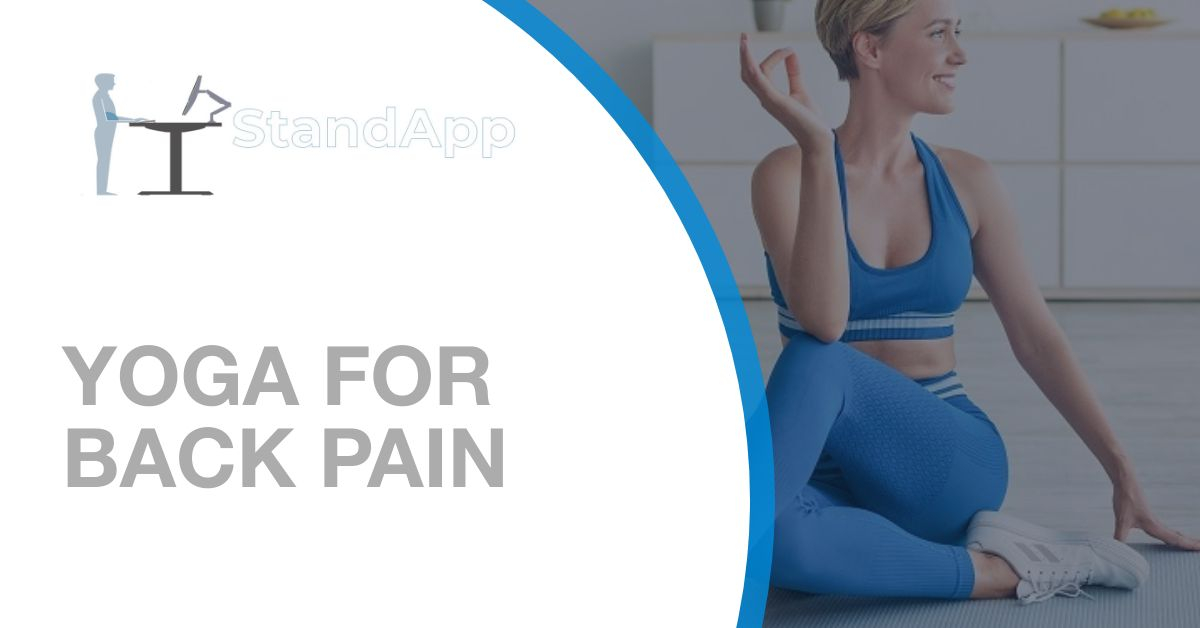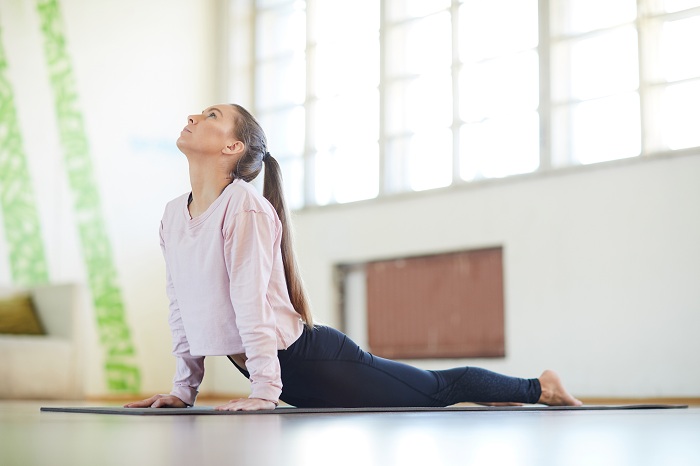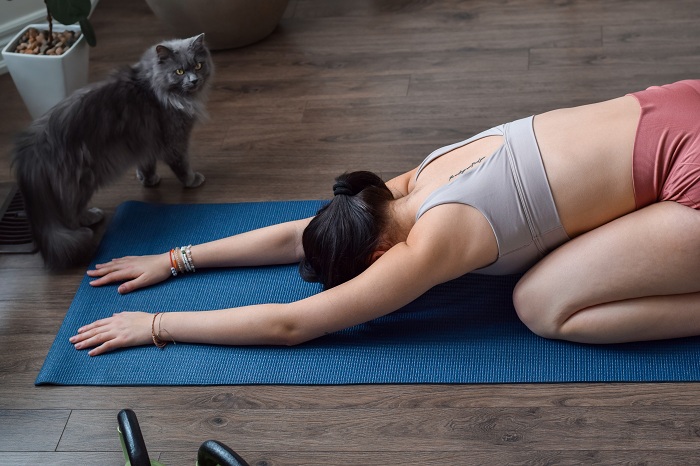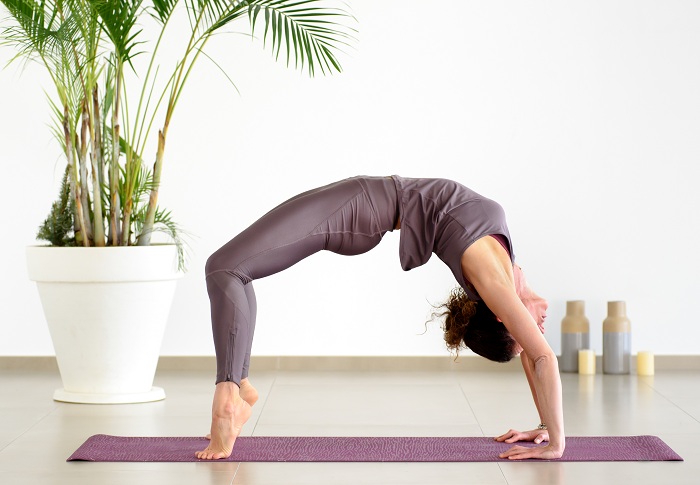
6 Yoga Poses for Back Pain
There are many yoga poses for lower back pain, and these six yoga poses have been proven to help relieve lower back pain.
In this blog post, we will go over the benefits of each yoga pose and show you how to perform it with step-by-step instructions. You can use any of these yoga poses at home or in a yoga class to improve your quality of life.
Yoga for Back Pain
1. Cat Cow Pose
The cat cow pose is a traditional yoga position that allows you to stretch your back and shoulders. The name comes from the animal form; it’s like lying on all fours with an imaginary Cow in front of us as we look up into its face (think: resting among bovines).
This isolates muscles for relief, allowing them time to heal without compression or shearing forces which will make things worse instead.
For this yoga pose, you should start on your hands and knees. Keep your arms straight with palms flat against the floor. Then, drop your belly to the ground so that it’s almost touching the mat underneath you. Finally, lower your head between or beside shoulders while arching back up towards sky in a cat-like position.
You can hold this yoga pose for about 30 seconds, and you should do it several times to feel the full benefits.

2. Downward Facing Dog Pose
Some people who suffer from lower back pain may want to try downward facing dog pose. This is a simple yoga position that can provide relief for you, as it takes pressure off the spine and stretches out tight muscles in the hips while raising them high into reaching inverted v-shape with arms overhead or at sides depending on what works best for individual poses flexibility levels.
It’s also helpful for yoga beginners because it is a fairly easy pose to do. You should start on all fours with palms flat against the mat and feet resting close together. Then, you slowly raise your tailbone up towards the sky while pushing hips back until they are parallel to heels (keep arms straight). Finally, press into fingers and toes and lift your chest slightly so you can feel a stretch in the back of shoulders and spine.
You should hold this yoga pose for about 30 seconds, or longer if it feels comfortable for that amount of time.
Some yoga beginners might find downward facing dog pose difficult at first; however, with practice they will get better at doing yoga and yoga positions.
This yoga pose is a great way to stretch out the back after sitting at a desk all day or driving in the car for hours on end.
Benefits: Stretches shoulders, arms, hamstrings & lower back
Pro Tip: Keep your gaze straight down towards floor as you hold yoga position; this will help stretch out spine and keep yoga beginner from feeling dizzy or nauseous.
3. Child’s pose with a pillow under the head for neck pain relief
This is a pose that can be done in the comfort of home, and it also helps with back pain. It’s called child’s pose because when we lie down on our backs with both hands under head balancing soft pillows at various heights so they support your neck comfortably while relaxing all muscles from shoulders down to hips (you should feel like you’re floating).

The position relaxes tightness or tension throughout body leading into other yoga postures more easily breathing deeply which has been linked highly beneficial effects such as reducing blood pressure after only 15 minutes.
Benefits: Relaxing yoga pose that relieves tension; beneficial for those with tight muscles and back pain.
Pro Tip: If you have any neck injuries, yoga beginners should try not to put hands under head while lying down.
4. Cobra Pose
Cobra pose is a yoga move that works the back and shoulders to relieve tension. Lie face-up on an exercise mat or carpet, place hands at shoulder level with elbows hugged against body; then raise both legs into pretzel format until all four feet are flat on ground close together without bending knees (a straight line from ankles through hip sockets).
To avoid strain, maintain a neutral spine and press the head down and into the mat if required so that your gaze isn’t excessively upward. This allows for greater chest openness and strengthening of the upper back.
First yoga position you should hold is for about 30 seconds, then lower down to floor with control by slowly bending elbows, releasing head last so neck isn’t strained or pushed into ground harshly. This yoga move can be done daily to help strengthen body and improve flexibility in spine.
Benefits: Stretches shoulders, arms, hamstrings & lower back.
Pro Tip: If yoga beginner has difficulty lowering themselves down towards floor with control, yoga teacher can assist by placing hands on yoga students’ shoulders to help ease them slowly downwards.
5. Bridge Pose
Bridge pose is one of the best poses for back pain. It stretches and elongates your body while also working on floor strength, balance, flexibility – all things you need in order to live an active lifestyle!
Tucking in at either end creates gentle curves along every muscle in between which will help relieve tension caused by poor posture throughout our day (and avoid future discomfort).
The key here isn’t doing too much; instead making sure each segment has enough time so that they can truly release any built up stress that’s been stored over time.

Benefits: Stretches shoulders, arms, hamstrings & lower back; yoga moves relieve tension and stress along entire body.
Pro Tip: Try not to extend yoga pose with legs lifted too high as this may create strain on hips or knees which can lead future injury if done repeatedly.
6. Pigeon Pose
Pigeon Pose is a pose that helps with back pain. It involves lying on your stomach and raising one leg in the air, while keeping other bent at 90 degrees or more for seated versions of this position.
The idea behind it? Lifting up from all angles relieves stress off both shoulders as well as any discomfort you might be feeling within joints where they meet muscles (such as ankles).
Benefits: Stretches hips, thighs & ankles; yoga move relieves tension throughout entire body.
Pro Tip: Keep spine straight and pressed firmly into the floor to avoid strain on your lower back (which may cause future injury).
While doing yoga poses can help improve your quality of life, it is important to always consult a doctor before starting any new fitness routine like yoga postures or yoga positions.



